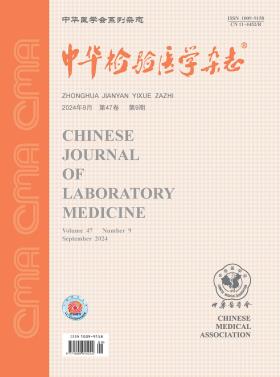Analysis of the autoantibodies characteristics of 77 anti-soluble liver antigen positive patients with liver diseases
Q4 Health Professions
引用次数: 0
Abstract
Objective To understand the characteristics and clinical significance of anti-soluble liver antigen antibody (anti-SLA) in patients with liver diseases. Methods Serum samples from seventy-seven patients with anti-SLA were collected from Beijing You'An Hospital during the period between January 2010 and December 2018. Anti-SLA, anti-liver cytosol type 1 antibody (anti-LC1), anti-glycoprotein 210 antibody(anti-gp210) and anti-nuclear body protein sp100 antibody(anti-sp100) were detected by immunoblotting; indirect immunofluorescence assay used for detecting anti-nuclear antibody (ANA), anti-mitochondrial antibody (AMA), anti-smooth muscle antibody (SMA), and anti-liver kidney microsome antibody (anti-LKM). One-way analysis of variance was used to compare the ages of different anti-SLA groups. The non-parametric rank sum test was used to compare the liver function indexes and immunoglobulins in different intensity groups of anti-SLA. P<0.05 was considered statistically significant. Further comparisons were made between the two groups, the correction level α′=0.008 3, P<0.008 3 was considered statistically significant. Results The average age of 77 anti-SLA positive patients was (52.50±1.25) years old, 70 females (90.9%) and 7 males (9.1%). 80.5% of anti-SLA-positive patients (62/77 cases) were strongly positive at the time of initial diagnosis (+++ to ++++).The Alanine aminotransferase (ALT) level in the SLA++ group was higher than that in the SLA++++ group (232.7 U/L vs 65.6 U/L,χ2=7.751,P=0.005) and the immunoglobulin M(IgM) level in the SLA+++ group was lower than that in the SLA++++ group (1 270 mg/L vs 2 270 mg/L,χ2=8.337,P=0.004).There was no significant difference in age, other liver function and immunological indicators among the different groups.Seventy cases (90.9%) were both anti-SLA and ANA positive, 13 cases (16.9%) were positive with SMA, and none positive with anti-LKM and anti-LC1. Among anti-SLA positive patients, 58 cases were diagnosed with autoimmune hepatitis (AIH), 12 were AIH/primary biliary cholangitis (PBC) overlap syndrome (OS), 2 were drug-induced liver injury, 2 were chronic hepatitis B, and 3 were hepatitis A, hepatitis E and acquired immune deficiency syndrome (AIDS) with liver injury, respectively.Cases of AIH and AIH/PBC OS accounted for 90.9% (70/77 cases) of anti-SLA-positive patients, and 5 of 7 patients diagnosed with non-AIH (and OS) had elevated IgG, showing AIH feature.92.3% (12/13 cases) of anti-SLA with high titers of AMA were diagnosed as AIH/PBC overlap syndrome. Of the 77 anti-SLA-positive patients, 28 (36.4%) had advanced or end-stage liver disease, including decompensated cirrhosis (22 cases), chronic acute liver failure (4 cases), and liver transplantation (1 case) and death from liver failure (1 case). Conclusions Anti-SLA has high diagnostic specificity for AIH;anti-SLA positive in patients with PBC should be an important biomarker for the diagnosis of AIH/PBC overlap syndrome. Key words: Liver diseases; Hepatitis, autoimmune; Autoantibodies77例抗可溶性肝抗原阳性肝病患者自身抗体特征分析
目的了解肝病患者抗可溶性肝抗原抗体(anti-SLA)的特点及临床意义。方法收集2010年1月至2018年12月北京佑安医院77例抗sla患者的血清样本。免疫印迹法检测抗sla、抗肝细胞质溶胶1型抗体(抗lc1)、抗糖蛋白210抗体(抗gp210)和抗核体蛋白sp100抗体(抗sp100);间接免疫荧光法用于检测抗核抗体(ANA)、抗线粒体抗体(AMA)、抗平滑肌抗体(SMA)、抗肝肾微粒体抗体(抗lkm)。采用单因素方差分析比较不同抗sla组患者的年龄。采用非参数秩和检验比较抗sla不同剂量组肝功能指标和免疫球蛋白的变化。P<0.05为差异有统计学意义。两组进一步比较,校正水平α′=0.008 3,P<0.008 3认为有统计学意义。结果77例抗sla阳性患者平均年龄为(52.50±1.25)岁,其中女性70例(90.9%),男性7例(9.1%)。抗- sla阳性患者中有80.5%(62/77)在初诊时呈强阳性(+++ ~ ++++)。SLA++组丙氨酸转氨酶(ALT)水平高于SLA++++组(232.7 U/L vs 65.6 U/L,χ2=7.751,P=0.005), SLA++组免疫球蛋白M(IgM)水平低于SLA++++组(1 270 mg/L vs 2 270 mg/L,χ2=8.337,P=0.004)。各组大鼠的年龄、其他肝功能及免疫指标差异无统计学意义。70例(90.9%)抗sla和ANA均阳性,SMA阳性13例(16.9%),抗lkm和抗lc1均无阳性。抗sla阳性患者中,自身免疫性肝炎(AIH) 58例,AIH/原发性胆管炎(PBC)重叠综合征(OS) 12例,药物性肝损伤2例,慢性乙型肝炎2例,甲型肝炎、戊型肝炎和获得性免疫缺陷综合征(AIDS)合并肝损伤3例。AIH和AIH/PBC OS占抗sla阳性患者的90.9%(70/77例),诊断为非AIH(和OS)的7例患者中有5例IgG升高,表现为AIH特征,92.3%(12/13例)抗sla高滴度的患者诊断为AIH/PBC重叠综合征。在77例抗sla阳性患者中,28例(36.4%)患有晚期或终末期肝病,包括失代偿性肝硬化(22例)、慢性急性肝衰竭(4例)、肝移植(1例)和肝衰竭死亡(1例)。结论抗sla对AIH具有较高的诊断特异性,PBC患者抗sla阳性应作为诊断AIH/PBC重叠综合征的重要生物标志物。关键词:肝脏疾病;肝炎,自身免疫性;自身抗体
本文章由计算机程序翻译,如有差异,请以英文原文为准。
求助全文
约1分钟内获得全文
求助全文
来源期刊

中华检验医学杂志
Health Professions-Medical Laboratory Technology
CiteScore
0.40
自引率
0.00%
发文量
8037
期刊介绍:
 求助内容:
求助内容: 应助结果提醒方式:
应助结果提醒方式:


